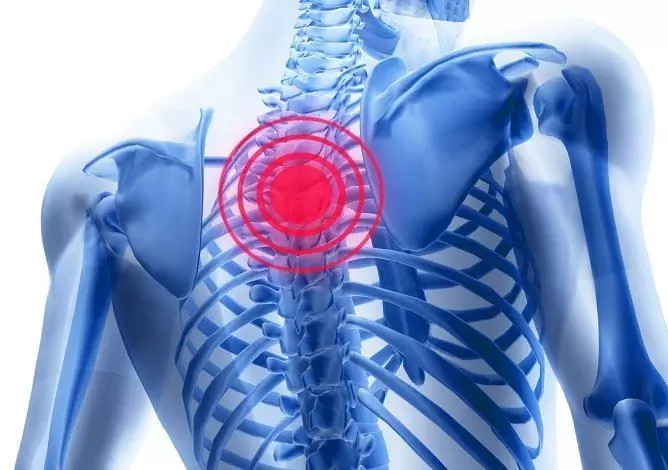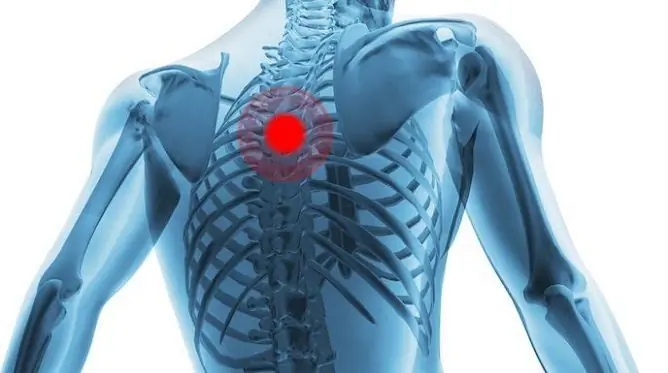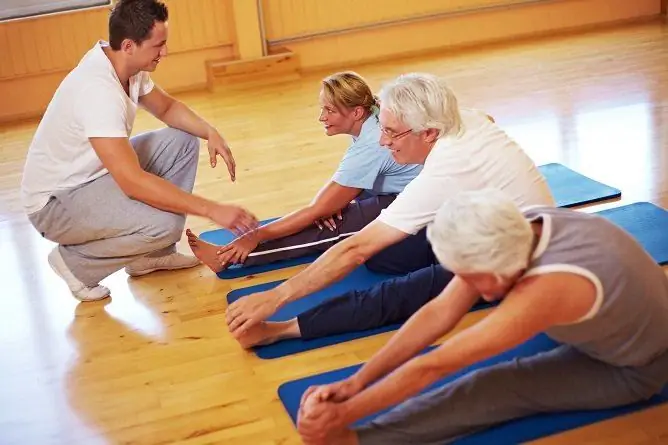- Author Rachel Wainwright [email protected].
- Public 2024-01-15 19:51.
- Last modified 2025-11-02 20:14.
Thoracic osteochondrosis
The content of the article:
- Causes and risk factors
- Classification
- Symptoms of breast osteochondrosis
- Diagnostics
- Treatment of breast osteochondrosis
- Potential consequences and complications
- Forecast
- Prevention
Thoracic osteochondrosis is a chronic disease, which is based on degenerative-dystrophic lesions of the intervertebral cartilaginous discs, which leads to reactive changes in the vertebral bodies and surrounding soft tissues. The disease is widespread and mainly affects people of the most working age (25-45 years).
Thoracic osteochondrosis is much less common than lumbar or cervical. This is due to the fact that this part of the spine has less static and motor loads than others. However, osteochondrosis of the thoracic spine is much more difficult to diagnose, since in most cases it proceeds, imitating diseases of the lungs, heart, organs of the upper digestive system.

Source: ponchikov.net
Causes and risk factors
Currently, the exact reasons for the development of chest osteochondrosis have not been established. Experts have proposed many theories (infectious-allergic, hereditary, mechanical, hormonal, vascular), but none of them gives a clear and complete explanation of the pathological changes occurring in the spine and leading to tissue degeneration. Most likely, several different factors are simultaneously involved in the pathological mechanism of the development of thoracic osteochondrosis. But the main importance belongs to long-term static-dynamic overloads of the spinal segment.
The factors causing such overloads are:
- anomalies in the structure of the spine;
- asymmetric arrangement of joint spaces in the intervertebral joints;
- congenital narrowing of the spinal canal;
- spondylogenic muscle (myofascial, reflected) and / or somatic (reflected, arising against the background of a number of diseases of the blood vessels and internal organs) pain;
- prolonged exposure to vibration, such as in motor vehicle drivers;
- physical stress;
- obesity;
- smoking;
- sedentary lifestyle (physical inactivity);
- psychosocial factors.
The mobility of the spine is provided by the intervertebral discs, which also play a shock-absorbing role. In their center there is an elastic gelatinous core, which contains a large amount of water. With osteochondrosis, the nucleus begins to lose water as a result of demineralization of polysaccharides. Over time, the nucleus flattens, and with it the intervertebral disc itself flattens. Under the influence of mechanical stress, the annulus fibrosus protrudes, this process is called protrusion. Subsequently, cracks appear in the disc, through which fragments of the nucleus pulposus fall out, that is, the formation of a herniated intervertebral disc occurs.

Source: imperial-college.ru
Reducing the height of the disc leads to convergence of adjacent vertebrae, disruption of the anatomy of the facet joints. All of this triggers reactive inflammation in the facet joints and the soft tissue surrounding them. In addition, the convergence of the vertebral bodies is accompanied by stretching of the joint capsules, and the affected segment of the spine becomes unstable. In this case, the vertebral bodies receive excessive mobility, which can become the cause of the infringement of the spinal roots and the development of radicular syndrome.
Against the background of thoracic osteochondrosis, the bone tissue of the vertebral bodies gradually grows and forms bone outgrowths (osteophytes). They can also cause radicular syndrome or compression myelopathy (compression of the spinal cord).

Source: nevralgia24.ru
Classification
The classification of thoracic osteochondrosis is based on the syndromic principle. Depending on which nerve formations are affected by the affected structures of the spine, the following syndromes are distinguished:
- compression - its development is based on tension, deformation or compression of the nerve root, part of the spinal cord or a blood vessel, depending on which spinal, vascular or radicular syndromes develop;
- reflex - associated with reflex tension of innervated muscles, dystrophic and vascular disorders;
- myoadaptive.
Symptoms of breast osteochondrosis
The main symptom of breast osteochondrosis is pain. In most cases, it is dull and mild.
Prolonged irritation of the spinal roots causes a violation of the innervation of internal organs. Depending on the level of the lesion, thoracic osteochondrosis can proceed under the guise of somatic pathologies:
In this regard, the most common symptoms of breast osteochondrosis are:
- pain in the chest area (behind the sternum, in the side, back, in the intercostal space) - can be either sharp or aching, dull; often radiate to the hand;
- pain in the epigastric region - occurs regardless of the nature of the diet, the characteristics of the diet; often combined with heartburn, nausea, vomiting;
- pain in the right hypochondrium - aggravated by changing the position of the patient's body, sneezing, coughing;
- pain in the lumbar region - imitate an attack of renal colic, often combined with dysuric disorders.
When the nerve root is compressed, a patient with thoracic osteochondrosis develops an attack of intercostal neuralgia. It is characterized by the occurrence of acute pain in one half of the chest (thoracalgia). Painful sensations are shingles in nature and spread along the course of one of the intercostal nerves from the spine to the sternum. Patients describe them as "electric shock" or "lumbago". The pain can radiate to the epigastric region, retrosternal region, scapula, arm and be combined with some other symptoms (local hyperhidrosis, pallor or flushing of the skin) associated with damage to the sympathetic fibers of the intercostal nerve.
For intercostal neuralgia, painful paroxysms are characteristic, lasting from several seconds to several minutes. During an attack, the pain becomes unbearable. Trying to somehow alleviate their condition, patients freeze in a certain position of the body, avoiding deep breaths, coughing, sneezing, turning.
Outside of a painful attack, patients have paresthesias (subjective disorders of skin sensitivity in the form of creeping creeps, tickling, tingling needles) along the intercostal space.

Source: mcars.spb.ru
Diagnostics
Diagnosis of thoracic osteochondrosis is carried out on the basis of data from an objective examination of the patient, laboratory and instrumental examination, including:
- complete blood count (moderate leukocytosis, increased ESR);
- serum electrolytes (lowering calcium levels);
- general urine analysis;
- blood chemistry;
- X-ray examination of the thoracic spine (flattening of the intervertebral disc, deformation of the closing plates of the bodies of adjacent vertebrae, displacement of the bodies of adjacent vertebrae relative to each other);
- spinal scintigraphy (reveals the process of active mineralization of bone tissue of the vertebral bodies);
- myelography;
- computed and magnetic resonance imaging.
Thoracic osteochondrosis requires differential diagnosis with the following diseases and pathological conditions:
- dyshormonal spondylopathy;
- spondylolisthesis;
- inflammatory processes;
- ankylosing spondylitis;
- osteomyelitis of the spine;
- rheumatoid arthritis;
- neoplastic processes (metastases or primary tumors of the chest);
- spinal fractures;
- diseases of the gastrointestinal tract (chronic pancreatitis, gastric ulcer and duodenal ulcer, diverticulitis, irritable bowel syndrome);
- diseases of the genitourinary system (urolithiasis, pyelonephritis);
- diseases of the cardiovascular system (ischemic heart disease, arrhythmias).
Treatment of breast osteochondrosis
Treatment of breast osteochondrosis is carried out on an outpatient basis. In case of severe pain syndrome, the patient is prescribed bed rest for 2-3 days. Traction of the affected segment of the spine is shown, which makes it possible to eliminate the compression of the nerve root and thereby relieve pain. In case of severe pain syndrome, soft tissue infiltration is performed with 2% novocaine solution. In a short course, non-steroidal anti-inflammatory drugs can be prescribed.
The scheme of complex treatment of chest osteochondrosis also includes:
- antihistamines;
- B vitamins;
- tranquilizers;
- acupuncture;
- massage;
- manual therapy.
After the patient's condition improves, he is sent to physical therapy classes. Regular exercise in thoracic osteochondrosis contributes to the formation of a well-developed muscle corset, which allows you to keep the spine in the correct physiological position, eliminates unnecessary static loads.
Of no small importance in the treatment of chest osteochondrosis is given to regular moderate physical activity (swimming, yoga, tai chi), normalization of body weight. Jumping, running, weightlifting and other sports, accompanied by increased stress on the spine, are contraindicated.

Source: my-sustav.ru
Surgical treatment of thoracic osteochondrosis is indicated only in the case of significant spinal cord compression. In such cases, depending on the indications, perform:
- stabilization of the spinal segment;
- replacement of the affected disc with an artificial implant;
- laser disc reconstruction;
- puncture vaporization of the affected disc;
- microdiscectomy.
Potential consequences and complications
Prolonged irritation or compression of the nerve roots can provoke the development of somatic diseases of the chest, upper digestive system, and kidneys. The greatest danger of thoracic osteochondrosis is for the myocardium.
Also, the consequences of breast osteochondrosis can be diseases of the esophagus, stomach, duodenum, pancreas, gallbladder, lungs, and the formation of an intervertebral hernia.
Forecast
Thoracic osteochondrosis is characterized by an undulating course, in which remissions are accompanied by exacerbations. With timely treatment started, the patient observes all the doctor's recommendations regarding both the treatment of the disease and changes in lifestyle, the prognosis is favorable.
Prevention
Prevention of chest osteochondrosis includes:
- normalization of body weight;
- to give up smoking;
- active lifestyle.
YouTube video related to the article:

Elena Minkina Doctor anesthesiologist-resuscitator About the author
Education: graduated from the Tashkent State Medical Institute, specializing in general medicine in 1991. Repeatedly passed refresher courses.
Work experience: anesthesiologist-resuscitator of the city maternity complex, resuscitator of the hemodialysis department.
The information is generalized and provided for informational purposes only. At the first sign of illness, see your doctor. Self-medication is hazardous to health!






